Lisa Sachs's Blog, page 5
September 19, 2017
We Just Came Back From Canada - Sorry, Eh
“What brings you to Vancouver?” we were asked at Customs.“We’re visiting. We heard how beautiful Vancouver was and we’ve been wanting to visit for a long time,” said my husband. “If we really like it, we may defect,” I joked.With that Canadian sense of humor, the customs officer told us that we were always welcome in Canada.
We enjoyed that humor when we attended a sketch improv group’s show called “Oh Canada.” The audience, mostly Canadians, laughed at their own foibles in that dry, self-deprecating way. During intermission, the audience was asked to fill out slips saying what they loved most about Canada. I wrote that I loved the way everyone said “Sorry” all the time. To my surprise, the first skit after the intermission was “Sorry, Eh.” All the actors in the ensemble got the chance to correct each other prefacing it with – you guessed it – Sorry Eh. By the time the skit was finished, all the ensemble members had their chance to say “Sorry” about just about every aspect of Canadian life.
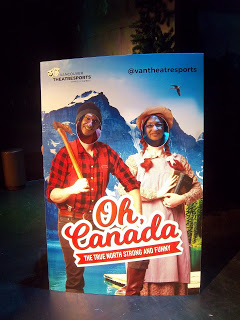 Poster at Oh Canada SkitWe witnessed this tendency to apologize in more important ways as we traveled through Vancouver, Victoria, and the Cowichan Valley on Vancouver Island. Vancouver has an outstanding Anthropology Museum on the campus of BCU (British Columbia University) where we spent many hours. Their collection of native American – or as Canadians call it First Nations – artifacts, totem poles, and artwork was fascinating. Free tours of exhibits are given throughout the day and the history of injustices done to First Nations by Canada is fully acknowledged by the tour guides.
Poster at Oh Canada SkitWe witnessed this tendency to apologize in more important ways as we traveled through Vancouver, Victoria, and the Cowichan Valley on Vancouver Island. Vancouver has an outstanding Anthropology Museum on the campus of BCU (British Columbia University) where we spent many hours. Their collection of native American – or as Canadians call it First Nations – artifacts, totem poles, and artwork was fascinating. Free tours of exhibits are given throughout the day and the history of injustices done to First Nations by Canada is fully acknowledged by the tour guides.
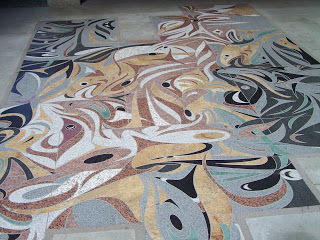 At entrance of the Museum
At entrance of the Museum
 Sculpture by Bill Reid, First Nation ArtistIn Victoria, we took a tour of the Provincial Capitol Building. Again, the guide talked about Canada’s past injustices to their First Nations and to Japanese-Canadians.
Sculpture by Bill Reid, First Nation ArtistIn Victoria, we took a tour of the Provincial Capitol Building. Again, the guide talked about Canada’s past injustices to their First Nations and to Japanese-Canadians.
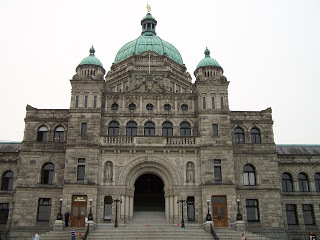 British Columbia Provincial Capitol BuildingThe town of Duncan population 4,944 in the Cowichan Valley has 30 totem poles and a museum featuring the history of First Nations in that part of Canada. We took this very interesting tour and learned a lot.
British Columbia Provincial Capitol BuildingThe town of Duncan population 4,944 in the Cowichan Valley has 30 totem poles and a museum featuring the history of First Nations in that part of Canada. We took this very interesting tour and learned a lot.
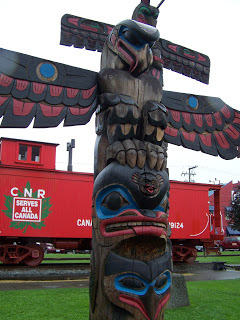 Totem Pole
Totem Pole
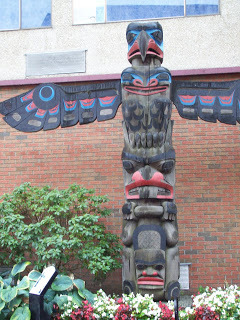 Totem Pole in Duncan
Totem Pole in Duncan
Canada and the United States share a history of injustice toward their native American and other nonwhite populations – the spread of European diseases, usurping of native lands, relegation of First Nations people to reservations, boarding schools that erased native culture. They also interned Japanese-Canadians during World War II and then didn’t allow them to return to British Columbia when the War was over. The main difference between the two countries is that the Canadians have acknowledged their wrongdoing and said “Sorry” as they go forward as a multi-racial society. They apologized and arranged reparations for the Japanese in 1988. They apologized to the First Nations in 2008. In the meantime, we Americans still argue among ourselves about whether or not to keep our Indian sports mascots despite many Native Americans who have protested them saying how insulted they feel by those mascots.
We can’t undo the past but we can acknowledge our wrongdoing as a society, say “Sorry,” and change our collective behavior going forward. We in the United States need some lessons from Canada in saying “Sorry.”
We enjoyed that humor when we attended a sketch improv group’s show called “Oh Canada.” The audience, mostly Canadians, laughed at their own foibles in that dry, self-deprecating way. During intermission, the audience was asked to fill out slips saying what they loved most about Canada. I wrote that I loved the way everyone said “Sorry” all the time. To my surprise, the first skit after the intermission was “Sorry, Eh.” All the actors in the ensemble got the chance to correct each other prefacing it with – you guessed it – Sorry Eh. By the time the skit was finished, all the ensemble members had their chance to say “Sorry” about just about every aspect of Canadian life.
 Poster at Oh Canada SkitWe witnessed this tendency to apologize in more important ways as we traveled through Vancouver, Victoria, and the Cowichan Valley on Vancouver Island. Vancouver has an outstanding Anthropology Museum on the campus of BCU (British Columbia University) where we spent many hours. Their collection of native American – or as Canadians call it First Nations – artifacts, totem poles, and artwork was fascinating. Free tours of exhibits are given throughout the day and the history of injustices done to First Nations by Canada is fully acknowledged by the tour guides.
Poster at Oh Canada SkitWe witnessed this tendency to apologize in more important ways as we traveled through Vancouver, Victoria, and the Cowichan Valley on Vancouver Island. Vancouver has an outstanding Anthropology Museum on the campus of BCU (British Columbia University) where we spent many hours. Their collection of native American – or as Canadians call it First Nations – artifacts, totem poles, and artwork was fascinating. Free tours of exhibits are given throughout the day and the history of injustices done to First Nations by Canada is fully acknowledged by the tour guides. At entrance of the Museum
At entrance of the Museum
 Sculpture by Bill Reid, First Nation ArtistIn Victoria, we took a tour of the Provincial Capitol Building. Again, the guide talked about Canada’s past injustices to their First Nations and to Japanese-Canadians.
Sculpture by Bill Reid, First Nation ArtistIn Victoria, we took a tour of the Provincial Capitol Building. Again, the guide talked about Canada’s past injustices to their First Nations and to Japanese-Canadians. British Columbia Provincial Capitol BuildingThe town of Duncan population 4,944 in the Cowichan Valley has 30 totem poles and a museum featuring the history of First Nations in that part of Canada. We took this very interesting tour and learned a lot.
British Columbia Provincial Capitol BuildingThe town of Duncan population 4,944 in the Cowichan Valley has 30 totem poles and a museum featuring the history of First Nations in that part of Canada. We took this very interesting tour and learned a lot.
 Totem Pole
Totem Pole Totem Pole in Duncan
Totem Pole in DuncanCanada and the United States share a history of injustice toward their native American and other nonwhite populations – the spread of European diseases, usurping of native lands, relegation of First Nations people to reservations, boarding schools that erased native culture. They also interned Japanese-Canadians during World War II and then didn’t allow them to return to British Columbia when the War was over. The main difference between the two countries is that the Canadians have acknowledged their wrongdoing and said “Sorry” as they go forward as a multi-racial society. They apologized and arranged reparations for the Japanese in 1988. They apologized to the First Nations in 2008. In the meantime, we Americans still argue among ourselves about whether or not to keep our Indian sports mascots despite many Native Americans who have protested them saying how insulted they feel by those mascots.
We can’t undo the past but we can acknowledge our wrongdoing as a society, say “Sorry,” and change our collective behavior going forward. We in the United States need some lessons from Canada in saying “Sorry.”
Published on September 19, 2017 06:00
December 26, 2016
In My Journey Through Life, A Real Surprising Development
Readers, something really surprising has happened. My blog has been hacked by Russian hackers. Don’t worry that I’ve flipped out. I know it’s them because in the statistics, I see the largest number of my readers are in Russia. Besides that, I keep getting anonymous comments that don’t make any sense. Sometimes they’ve been just a bunch of numbers. Other times they’re a bunch of nonsense words and I’ve had to send them all to spam. Who do they think I am - Hillary Clinton? I’m kind of flattered that they think I’m someone prominent.
So I’m thinking of sending them a comment in reply. Let me know what you think.
Dear Russian Hackers,
I don’t know why you’re bothering to hack my blog, but I kind of feel sorry for you because you’ve wasted a whole lot of your time. You’re not going to find out anything from me that you couldn’t find out by reading the newspapers. I’m just a private American citizen exercising my freedom of speech while I still have it. The events I write about are all public knowledge that I’m merely expressing my opinion about.
It reminds me of two funny FBI stories. One was an old friend of mine was a member of the Communist Party. The FBI sent an agent to spy on him. They spent so much time together that they got to be friends. When the FBI agent’s dog ran away, my friend helped him to look for his dog.
During the Vietnam War, my friends and I went to an anti-war march. We met a man who was wearing a “May 2nd Movement” campaign button. I asked him what that was and he told us. About a year later, one of my friends told me that he read a story about an FBI agent spending six months with the May 2nd Movement and finding out everything we did in our ten-minute conversation. I guess bureaucracies have something in common all over the world.
I’m willing to let bygones be bygones if you’d just say you’re sorry and unjumble my blog. While you’re at it, could you do me a favor? My aunt was a great cook and she made fabulous beef Stragonoff. I lost the recipe so could you send one to me? If you tell me your real name, I’ll mention it in my blog.
And that’s another thing: Just a friendly tip: You’d probably do better if you used an American name on your comments and improved your English grammar. Just saying.
Happy New Year. May 2017 be a more peaceful one for all of us. Lisa Sachs
So readers, until this hacking problem is resolved, I won’t be able to post anything. Happy New Year to all of you and may 2017 be a peaceful year for all the world.
So I’m thinking of sending them a comment in reply. Let me know what you think.
Dear Russian Hackers,
I don’t know why you’re bothering to hack my blog, but I kind of feel sorry for you because you’ve wasted a whole lot of your time. You’re not going to find out anything from me that you couldn’t find out by reading the newspapers. I’m just a private American citizen exercising my freedom of speech while I still have it. The events I write about are all public knowledge that I’m merely expressing my opinion about.
It reminds me of two funny FBI stories. One was an old friend of mine was a member of the Communist Party. The FBI sent an agent to spy on him. They spent so much time together that they got to be friends. When the FBI agent’s dog ran away, my friend helped him to look for his dog.
During the Vietnam War, my friends and I went to an anti-war march. We met a man who was wearing a “May 2nd Movement” campaign button. I asked him what that was and he told us. About a year later, one of my friends told me that he read a story about an FBI agent spending six months with the May 2nd Movement and finding out everything we did in our ten-minute conversation. I guess bureaucracies have something in common all over the world.
I’m willing to let bygones be bygones if you’d just say you’re sorry and unjumble my blog. While you’re at it, could you do me a favor? My aunt was a great cook and she made fabulous beef Stragonoff. I lost the recipe so could you send one to me? If you tell me your real name, I’ll mention it in my blog.
And that’s another thing: Just a friendly tip: You’d probably do better if you used an American name on your comments and improved your English grammar. Just saying.
Happy New Year. May 2017 be a more peaceful one for all of us. Lisa Sachs
So readers, until this hacking problem is resolved, I won’t be able to post anything. Happy New Year to all of you and may 2017 be a peaceful year for all the world.
Published on December 26, 2016 15:08
December 22, 2016
Only Twenty Nine Days Until Donald Trump Becomes President. What Do We Do Now?
There are only 28 days until Donald Trump becomes President of the United States of America. We have less than a month left to live in a Democracy that has a semblance of a social safety net, that has outlawed hate crimes, that guarantees us freedom of the press, speech, assembly, and religion. I feel that I must do something each day that counts toward saving the good that American has been and will be - until January 20th. The time to cry was after the election results came in. The time to panic is probably just beginning. I’m sure I’ll be doing plenty of that in the future. For now, I’m trying to be constructive.
Yesterday, December 21, I volunteered as I’ve been doing each Wednesday, at the ESL Café at the Skokie Library. Since this is a drop-in program for any immigrant who wants an opportunity to practice speaking English, we never have the exact same group that we had the week before. While a core group attends each week, people are always dropping in or out. We go around the room asking the people to introduce themselves. Today, people came to the group from Russia, Ukraine, Bulgaria, Syria, Iraq, Taiwan, Hong Kong, Japan, and Bosnia-Herzegovina.
The way in which people introduce themselves is always interesting. “I came from Syria five years ago,” says a woman. The tears she is trying not to shed are visible. “It used to be beautiful. Not now.” She cannot continue talking and we move on to the next person.Many of the people who attend the group talk about how grateful they are to be in America and Skokie, Illinois in particular. “I’ve been here over 20 years,” says a Russian woman. “God bless this country.”
We welcome them all to the group. I tell them my name and that I was born in New York and have spent most of my adult life in the Chicago area. “My grandparents came from Russia over 100 years ago,” I tell them. “We’re all immigrants or the children or grandchildren of immigrants. Welcome to the group. Welcome.”
I wonder how long I’ll be able to say that. Will any immigrants be truly welcome here during the next four years? I swallow a lump in my throat and my co-volunteer goes on to our activity for this day – sharing holiday music from our respective countries. Everyone seems to enjoy sharing it. We sing. We dance. We eat cookies from various countries that participants have brought in. We’re from many lands but we’ve shared our music, our dance, and our foods. We can no longer be strangers.
I’m grateful that I’ve had the opportunity to volunteer in this program, a joint project of the English Language Learners Center and the Skokie Library. How long will I be able to welcome new immigrants to America? I don’t know, but I’m determined to work with Immigrant Rights Groups to make sure that America remains a beacon of hope to the world.
The countdown continues. I hope to do something today and every day to make the next month meaningful.
Yesterday, December 21, I volunteered as I’ve been doing each Wednesday, at the ESL Café at the Skokie Library. Since this is a drop-in program for any immigrant who wants an opportunity to practice speaking English, we never have the exact same group that we had the week before. While a core group attends each week, people are always dropping in or out. We go around the room asking the people to introduce themselves. Today, people came to the group from Russia, Ukraine, Bulgaria, Syria, Iraq, Taiwan, Hong Kong, Japan, and Bosnia-Herzegovina.
The way in which people introduce themselves is always interesting. “I came from Syria five years ago,” says a woman. The tears she is trying not to shed are visible. “It used to be beautiful. Not now.” She cannot continue talking and we move on to the next person.Many of the people who attend the group talk about how grateful they are to be in America and Skokie, Illinois in particular. “I’ve been here over 20 years,” says a Russian woman. “God bless this country.”
We welcome them all to the group. I tell them my name and that I was born in New York and have spent most of my adult life in the Chicago area. “My grandparents came from Russia over 100 years ago,” I tell them. “We’re all immigrants or the children or grandchildren of immigrants. Welcome to the group. Welcome.”
I wonder how long I’ll be able to say that. Will any immigrants be truly welcome here during the next four years? I swallow a lump in my throat and my co-volunteer goes on to our activity for this day – sharing holiday music from our respective countries. Everyone seems to enjoy sharing it. We sing. We dance. We eat cookies from various countries that participants have brought in. We’re from many lands but we’ve shared our music, our dance, and our foods. We can no longer be strangers.
I’m grateful that I’ve had the opportunity to volunteer in this program, a joint project of the English Language Learners Center and the Skokie Library. How long will I be able to welcome new immigrants to America? I don’t know, but I’m determined to work with Immigrant Rights Groups to make sure that America remains a beacon of hope to the world.
The countdown continues. I hope to do something today and every day to make the next month meaningful.
Published on December 22, 2016 07:26
November 15, 2016
Finding Optimism Now That Trump Is President-Elect
Dear Millenial Children and Friends,
I’m sorry that I wasn’t more encouraging on the phone Tuesday when we got the election results. I was too busy sobbing hysterically to think of anything hopeful.
Now that I have had a few days to reflect, I feel better about Trump’s winning. I’ve looked back at other horrible times that I’ve experienced in American history and realized that they passed.
The darkest era in my lifetime was the Vietnam War period. That unjustified war finally came to an end. That didn’t happen, however, because of the passage of time. It didn’t happen because the War petered out of its own accord. It ended because we intervened. We marched. We picketed. We campaigned for anti-war Congressional Candidates. We opposed the draft. We draft-counseled. We burned our draft cards. We went to Canada. We went to jail for draft resistance. We boycotted Dow Chemical for manufacturing napalm. We were neat and clean for Gene McCarthy. We campaigned for Bobby Kennedy. And finally, after several years, the government ran out of human cannon fodder and the War ended.
A famous Chinese curse is “May you live in interesting times.” I have already lived through one interesting time and I’m very distressed to find myself living through another one. This time will also pass, but it won’t pass by accident. We must do everything legally possible to prevent the worst of Trump’s policies from coming to fruition. We cannot let him shut down the free press. We cannot let him jail his political opponents. We cannot let him place heavy surveillance on our Muslim friends and neighbors. We cannot let him deport all our Mexican friends. We cannot allow African-Americans to be hounded and persecuted. We will support the disabled and demand that they are treated with the dignity that they deserve. We will stand up for women’s rights and refuse to let Trump turn back the clocks to the 1950’s. We will be there for our friends and family in the LGBTQ community.
We must organize. We must march. We must write to the newspapers and our Congresspeople. We must be involved. And with our intervention, this too will pass and America’s better angels will prevail again.
I’ll see you on the picket line or anywhere else we can stand up for all the good that America actually is. And this time will pass, too. If it doesn’t, I’ll meet you at Tim Horton’s for coffee and we’ll grieve for America together. It’ll be on me.
Love, Mom
I’m sorry that I wasn’t more encouraging on the phone Tuesday when we got the election results. I was too busy sobbing hysterically to think of anything hopeful.
Now that I have had a few days to reflect, I feel better about Trump’s winning. I’ve looked back at other horrible times that I’ve experienced in American history and realized that they passed.
The darkest era in my lifetime was the Vietnam War period. That unjustified war finally came to an end. That didn’t happen, however, because of the passage of time. It didn’t happen because the War petered out of its own accord. It ended because we intervened. We marched. We picketed. We campaigned for anti-war Congressional Candidates. We opposed the draft. We draft-counseled. We burned our draft cards. We went to Canada. We went to jail for draft resistance. We boycotted Dow Chemical for manufacturing napalm. We were neat and clean for Gene McCarthy. We campaigned for Bobby Kennedy. And finally, after several years, the government ran out of human cannon fodder and the War ended.
A famous Chinese curse is “May you live in interesting times.” I have already lived through one interesting time and I’m very distressed to find myself living through another one. This time will also pass, but it won’t pass by accident. We must do everything legally possible to prevent the worst of Trump’s policies from coming to fruition. We cannot let him shut down the free press. We cannot let him jail his political opponents. We cannot let him place heavy surveillance on our Muslim friends and neighbors. We cannot let him deport all our Mexican friends. We cannot allow African-Americans to be hounded and persecuted. We will support the disabled and demand that they are treated with the dignity that they deserve. We will stand up for women’s rights and refuse to let Trump turn back the clocks to the 1950’s. We will be there for our friends and family in the LGBTQ community.
We must organize. We must march. We must write to the newspapers and our Congresspeople. We must be involved. And with our intervention, this too will pass and America’s better angels will prevail again.
I’ll see you on the picket line or anywhere else we can stand up for all the good that America actually is. And this time will pass, too. If it doesn’t, I’ll meet you at Tim Horton’s for coffee and we’ll grieve for America together. It’ll be on me.
Love, Mom
Published on November 15, 2016 06:00
November 3, 2016
What My Travels Have Taught Me About the 2016 Election
I keep thinking of the trip we took to Argentina and Chile and the message in Rick Steves’ book Travel As A Political Act. He talks about the ways in which traveling to foreign countries has helped him to appreciate how fortunate he is to live in the United States of America. It has also helped him to realize that some other countries often have good solutions to problems and also offer their citizens a good life. Sometimes we Americans can even learn from them.
One of the most fascinating places we visited on that trip was the Eva Peron Museum in Buenos Aires. Before that visit, I had thought of the Perons as Fascists who had their opponents imprisoned, disappeared, and in many cases killed. They did do those things, but Eva Peron advocated for women’s rights and suffrage and spearheaded projects to improve the lives of the poor, also. The Perons ruled Argentina by the Cult of Personality, but they weren’t 100% evil. At least they set up low-cost housing projects and free health clinics for poor women thanks to Eva Peron. Even fifty years later, Argentines still revere Eva, visiting her grave and leaving flowers on it. I used to think that “Don’t cry for me Argentina” was just a song in the musical. When we visited the cemetery in Ricoleta and saw Eva Peron’s grave, I learned that it is the beginning of Eva Peron’s epitaph.
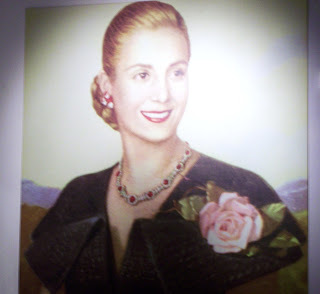 picture of Eva Peron hanging in the Eva Peron Museum, Buenos Aires
picture of Eva Peron hanging in the Eva Peron Museum, Buenos Aires
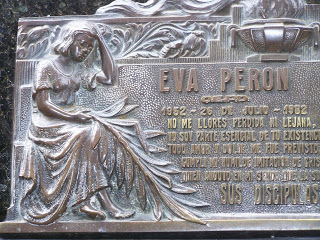 Eva Peron's gravesite in the Ricoleta Cemetary, Buenos AiresWhen I hear Donald Trump denouncing the free press and freedom of speech, ridiculing his opponents, and having opponents at his rallies physically manhandled, I think back to our trip to South America. Yes, Trump has also threatened to have his opponents jailed if he’s elected. He has roiled up latent feelings in Americans of racism, xenophobia, anti-Semitism, and misogyny promising to build a wall between the USA and Mexico, bar Muslims from America, and set up surveillance on immigrants and African-Americans. Donald Trump threatens to rule by the Cult of Personality without regard to any civil liberties.
Eva Peron's gravesite in the Ricoleta Cemetary, Buenos AiresWhen I hear Donald Trump denouncing the free press and freedom of speech, ridiculing his opponents, and having opponents at his rallies physically manhandled, I think back to our trip to South America. Yes, Trump has also threatened to have his opponents jailed if he’s elected. He has roiled up latent feelings in Americans of racism, xenophobia, anti-Semitism, and misogyny promising to build a wall between the USA and Mexico, bar Muslims from America, and set up surveillance on immigrants and African-Americans. Donald Trump threatens to rule by the Cult of Personality without regard to any civil liberties.
Argentina has since recovered from Juan Peron’s rule. Nevertheless, think of all the people who were disappeared, imprisoned, and killed while he ruled Argentina. America might survive a Trump presidency, but I shudder with fear to think of all the lives that will be ruined and lost if he comes to power.
Our trip to Argentina taught me that life is complicated and most people aren’t 100% good or 100% evil. At least Juan Peron had Eva to remind him to look out for the poor. Donald’s Melania shows no such inclination. I keep a kitchen magnet with a picture of Eva Peron on it to remind me daily how complicated human beings are. I hope and pray that if the worst happens and Donald Trump becomes President, I’ll find something positive in his actions. Right now, however, I can’t think of a blessed thing that would be. Please, America, come to your senses and vote against this harbinger of racism, misogyny, xenophobia, and anti-Semitism. It could be a matter of life and death for many of us.
One of the most fascinating places we visited on that trip was the Eva Peron Museum in Buenos Aires. Before that visit, I had thought of the Perons as Fascists who had their opponents imprisoned, disappeared, and in many cases killed. They did do those things, but Eva Peron advocated for women’s rights and suffrage and spearheaded projects to improve the lives of the poor, also. The Perons ruled Argentina by the Cult of Personality, but they weren’t 100% evil. At least they set up low-cost housing projects and free health clinics for poor women thanks to Eva Peron. Even fifty years later, Argentines still revere Eva, visiting her grave and leaving flowers on it. I used to think that “Don’t cry for me Argentina” was just a song in the musical. When we visited the cemetery in Ricoleta and saw Eva Peron’s grave, I learned that it is the beginning of Eva Peron’s epitaph.
 picture of Eva Peron hanging in the Eva Peron Museum, Buenos Aires
picture of Eva Peron hanging in the Eva Peron Museum, Buenos Aires
 Eva Peron's gravesite in the Ricoleta Cemetary, Buenos AiresWhen I hear Donald Trump denouncing the free press and freedom of speech, ridiculing his opponents, and having opponents at his rallies physically manhandled, I think back to our trip to South America. Yes, Trump has also threatened to have his opponents jailed if he’s elected. He has roiled up latent feelings in Americans of racism, xenophobia, anti-Semitism, and misogyny promising to build a wall between the USA and Mexico, bar Muslims from America, and set up surveillance on immigrants and African-Americans. Donald Trump threatens to rule by the Cult of Personality without regard to any civil liberties.
Eva Peron's gravesite in the Ricoleta Cemetary, Buenos AiresWhen I hear Donald Trump denouncing the free press and freedom of speech, ridiculing his opponents, and having opponents at his rallies physically manhandled, I think back to our trip to South America. Yes, Trump has also threatened to have his opponents jailed if he’s elected. He has roiled up latent feelings in Americans of racism, xenophobia, anti-Semitism, and misogyny promising to build a wall between the USA and Mexico, bar Muslims from America, and set up surveillance on immigrants and African-Americans. Donald Trump threatens to rule by the Cult of Personality without regard to any civil liberties.Argentina has since recovered from Juan Peron’s rule. Nevertheless, think of all the people who were disappeared, imprisoned, and killed while he ruled Argentina. America might survive a Trump presidency, but I shudder with fear to think of all the lives that will be ruined and lost if he comes to power.
Our trip to Argentina taught me that life is complicated and most people aren’t 100% good or 100% evil. At least Juan Peron had Eva to remind him to look out for the poor. Donald’s Melania shows no such inclination. I keep a kitchen magnet with a picture of Eva Peron on it to remind me daily how complicated human beings are. I hope and pray that if the worst happens and Donald Trump becomes President, I’ll find something positive in his actions. Right now, however, I can’t think of a blessed thing that would be. Please, America, come to your senses and vote against this harbinger of racism, misogyny, xenophobia, and anti-Semitism. It could be a matter of life and death for many of us.
Published on November 03, 2016 06:00
October 27, 2016
Holding Up Half the Sky at the Illinois Holocaust Museum
The exhibit “Half the Sky” now at the Illinois Holocaust Museum www.ilholocaustmuseum.org in Skokie, Illinois is definitely worth a visit. I went to see it and it didn’t disappoint. The Holocaust Museum and the Evanston YWCA www.ywca.org/evanston collaborated on it to increase public awareness of the many critical and sometimes life threatening problems that women face in parts of Africa, Asia, and the Middle East.
Skokie, a suburb just north of Chicago, is home to the largest concentration of Holocaust Survivors in the United States. In the 1970’s, out of about 70,000 residents, 7,000 were Holocaust Survivors and their families. Prior to the attempted march by Neo-Nazis through Skokie in 1976, many of those survivors had never spoken of their experiences. After that event, many realized that they had to speak out before it was too late to prevent another Holocaust from ever happening again and thus, the idea of the Illinois Holocaust Museum & Education Center was born. A small archive had been open since the 1970’s, but the current museum building opened to the public in 2009.
This exhibit is a great example of the Holocaust Museum’s collaborating with other organizations to bring awareness about current issues of racism. “Half the Sky” twill be there until January 22, 2017.
“Women hold up half the sky” is a Chinese saying and the idea for the book Half the Sky: Turning Oppression into Opportunity for Women Worldwide by Nicholas Kristof and Sherry DuWunn. They give heart rending examples of problems that women face in countries in Asia, Africa and the Middle East and some creative solutions that innovative, dedicated people have found and implemented to improve women’s lives in various locales. One of the most well known of these is extending micro-loans to women so that they can start their own small home-based businesses. These loans have enabled many women to become self-sufficient and support their families. In some instances, it has enabled women to thrive and in turn help other women.
While I had read Half the Sky several years ago, I still found it worthwhile seeing the exhibit at the Holocaust Museum. Not only does it discuss various solutions, it also displays many pictures of these women and videos of the women talking about how they’ve participated in the program and how it has impacted their lives. Many of the women shown had to risk their safety to participate. Others have dedicated their lives to some life-saving programs. It is inspiring to hear them.
The Holocaust Museum forbids picture taking in any of their exhibits so I have none to share with you.. You’ll have to go there and see for yourselves.
Skokie, a suburb just north of Chicago, is home to the largest concentration of Holocaust Survivors in the United States. In the 1970’s, out of about 70,000 residents, 7,000 were Holocaust Survivors and their families. Prior to the attempted march by Neo-Nazis through Skokie in 1976, many of those survivors had never spoken of their experiences. After that event, many realized that they had to speak out before it was too late to prevent another Holocaust from ever happening again and thus, the idea of the Illinois Holocaust Museum & Education Center was born. A small archive had been open since the 1970’s, but the current museum building opened to the public in 2009.
This exhibit is a great example of the Holocaust Museum’s collaborating with other organizations to bring awareness about current issues of racism. “Half the Sky” twill be there until January 22, 2017.
“Women hold up half the sky” is a Chinese saying and the idea for the book Half the Sky: Turning Oppression into Opportunity for Women Worldwide by Nicholas Kristof and Sherry DuWunn. They give heart rending examples of problems that women face in countries in Asia, Africa and the Middle East and some creative solutions that innovative, dedicated people have found and implemented to improve women’s lives in various locales. One of the most well known of these is extending micro-loans to women so that they can start their own small home-based businesses. These loans have enabled many women to become self-sufficient and support their families. In some instances, it has enabled women to thrive and in turn help other women.
While I had read Half the Sky several years ago, I still found it worthwhile seeing the exhibit at the Holocaust Museum. Not only does it discuss various solutions, it also displays many pictures of these women and videos of the women talking about how they’ve participated in the program and how it has impacted their lives. Many of the women shown had to risk their safety to participate. Others have dedicated their lives to some life-saving programs. It is inspiring to hear them.
The Holocaust Museum forbids picture taking in any of their exhibits so I have none to share with you.. You’ll have to go there and see for yourselves.
Published on October 27, 2016 06:00
October 13, 2016
Indigenous Peoples' Day At the Mitchell Museum
I can’t think of any place better to celebrate Indigenous Peoples’ Day than at the Mitchell Museum of the American Indian in Evanston. I decided to pay a visit there. The Mitchell Museum is small but they change their exhibits often so you can always see something new when you go there. Right now they have an exhibit of pictures of prominent women who are among the First Americans. They ask, “Did you know that these women are Native Americans?” For the most part, I didn’t know so thanks Mitchell Museum for trying to upend another stereotype.
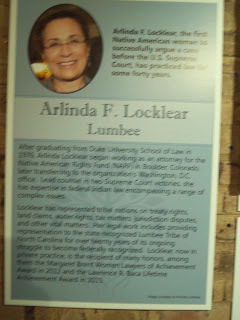 the first Native American woman to argue a case before the Supreme Court
the first Native American woman to argue a case before the Supreme Court
Evanston, Illinois joined the growing list of American cities and universities that have voted to replace Columbus Day with Indigenous Peoples’ Day. Most of the Evanston’s Indigenous Peoples’ Day events took place at The Mitchell Museum of the American Indian. In addition to the exhibits, they had a panel of three Native Americans participating in a discussion about identity, connection to roots, and racial stereotyping. Later, a concert by Native American musicians was presented at Northwestern University. The concert featured the group Scattering the Bones, a family of self-educated musicians. They played their music with heart were a pleasure to watch.
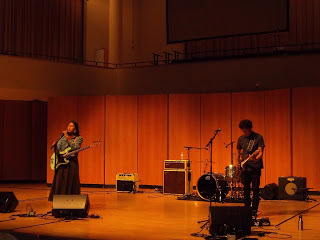 at the concert, Scattering the Bones group
at the concert, Scattering the Bones group
You’re probably asking yourself why we should replace Columbus Day with Indigenous Peoples’ Day. There are several reasons:
Since 1977 proposals to celebrate Indigenous Peoples’ Day instead of Columbus Day have been offered. Many people - especially the First Americans - have had issues about Columbus Day. For one, how can someone say he discovered a place that is already inhabited? There are various figures from studies for what the population of the Americas was just prior to 1492. The average number I saw was 54 million for North America and 37 million for South America.
Leif Erikson, a Norwegian explorer, “found” Canada in about 1003. One can argue that the indigenous peoples themselves discovered the Americas some 10,000 years ago [archaeological evidence is in dispute about the exact date] when they crossed the Land Bridge from Siberia into Alaska.
There are many myths about Columbus in American culture. Yes, he was the first European to settle down in what is now the United States of America. Was he a benefactor to the people he found there? According to historians, he was not and in fact committed genocide against the Native Americans living in Puerto Rico. Surely we can find a more appropriate person to create myths about.
I hope that next year Indigenous Peoples’ Day festivities in Evanston are better attended. All of us Americans should know more about Native American cultures and peoples. Over five million still live here. After all, they were here first.
 the first Native American woman to argue a case before the Supreme Court
the first Native American woman to argue a case before the Supreme CourtEvanston, Illinois joined the growing list of American cities and universities that have voted to replace Columbus Day with Indigenous Peoples’ Day. Most of the Evanston’s Indigenous Peoples’ Day events took place at The Mitchell Museum of the American Indian. In addition to the exhibits, they had a panel of three Native Americans participating in a discussion about identity, connection to roots, and racial stereotyping. Later, a concert by Native American musicians was presented at Northwestern University. The concert featured the group Scattering the Bones, a family of self-educated musicians. They played their music with heart were a pleasure to watch.
 at the concert, Scattering the Bones group
at the concert, Scattering the Bones groupYou’re probably asking yourself why we should replace Columbus Day with Indigenous Peoples’ Day. There are several reasons:
Since 1977 proposals to celebrate Indigenous Peoples’ Day instead of Columbus Day have been offered. Many people - especially the First Americans - have had issues about Columbus Day. For one, how can someone say he discovered a place that is already inhabited? There are various figures from studies for what the population of the Americas was just prior to 1492. The average number I saw was 54 million for North America and 37 million for South America.
Leif Erikson, a Norwegian explorer, “found” Canada in about 1003. One can argue that the indigenous peoples themselves discovered the Americas some 10,000 years ago [archaeological evidence is in dispute about the exact date] when they crossed the Land Bridge from Siberia into Alaska.
There are many myths about Columbus in American culture. Yes, he was the first European to settle down in what is now the United States of America. Was he a benefactor to the people he found there? According to historians, he was not and in fact committed genocide against the Native Americans living in Puerto Rico. Surely we can find a more appropriate person to create myths about.
I hope that next year Indigenous Peoples’ Day festivities in Evanston are better attended. All of us Americans should know more about Native American cultures and peoples. Over five million still live here. After all, they were here first.
Published on October 13, 2016 06:00
September 29, 2016
Peace in Columbia At Last - A Good Omen for the New Year
Ever since reading Even Silence Has An End, My Six Years of Captivity in the Columbian Jungle by Ingrid Betancourt, I have followed news of the talks between the Columbian government and the FARC, the leftwing guerilla group that has been terrorizing the people of Columbia for 52 years. I am not well versed enough in this conflict to have an opinion about whether or not the FARC’s demands had any justification. Whether they did or not, they held many Columbians terrorized and were responsible for the deaths of many. Their tactics were ruthless.
In her book, Ingrid Betancourt chronicles her experiences being kidnapped and held captive by the FARC in the jungles of Columbia from 2002 to 2008. It is amazing how far the depths are of people's cruelty to one another. In Ingrid Betancourt’s experience with the FARC, the depths of inhumanity seemed to have no bottom. I felt as though I was plodding through the jungle with her as I read her book. Several times Ms. Betancourt spent months planning an escape in intricate detail. Each time that she tried to carry out her plans she was recaptured and brought back to the camp where she was being held hostage. She maintained her sanity by praying, reading, exercising, and forging friendships with the other hostages whom the FARC was holding in captivity.
Ingrid Betancourt had a relatively high position in the Columbian government and she was fortunate in another respect. She had dual French/Columbian citizenship and the French government advocated for her release. The Columbian government did as well and finally rescued her and several other hostages in a raid on the FARC.
Now that the Columbian government and the FARC have signed a peace treaty after all these 52 years, I wonder what Ms. Betancourt will say about it. For me, it is a sign of hope. If after 52 years at war they can finally sign a peace treaty, there must be hope for the rest of the world. As Jews including myself prepare to usher in a New Year on our calendar, I take this event as an omen. I hope that in the year ahead the Israelis and Palestinians will return to the negotiating table and that other such conflicts will also find an end.
In her book, Ingrid Betancourt chronicles her experiences being kidnapped and held captive by the FARC in the jungles of Columbia from 2002 to 2008. It is amazing how far the depths are of people's cruelty to one another. In Ingrid Betancourt’s experience with the FARC, the depths of inhumanity seemed to have no bottom. I felt as though I was plodding through the jungle with her as I read her book. Several times Ms. Betancourt spent months planning an escape in intricate detail. Each time that she tried to carry out her plans she was recaptured and brought back to the camp where she was being held hostage. She maintained her sanity by praying, reading, exercising, and forging friendships with the other hostages whom the FARC was holding in captivity.
Ingrid Betancourt had a relatively high position in the Columbian government and she was fortunate in another respect. She had dual French/Columbian citizenship and the French government advocated for her release. The Columbian government did as well and finally rescued her and several other hostages in a raid on the FARC.
Now that the Columbian government and the FARC have signed a peace treaty after all these 52 years, I wonder what Ms. Betancourt will say about it. For me, it is a sign of hope. If after 52 years at war they can finally sign a peace treaty, there must be hope for the rest of the world. As Jews including myself prepare to usher in a New Year on our calendar, I take this event as an omen. I hope that in the year ahead the Israelis and Palestinians will return to the negotiating table and that other such conflicts will also find an end.
Published on September 29, 2016 15:10
September 22, 2016
Saving the Planet Scandinavian Style
From the moment we were hurtled into downtown from the Stockholm airport on their high speed train, it was clear to us that Scandinavia would be a place that was innovating ways to save the planet.
At the Stockholm airport, we took an elevator one floor down to get on a high-speed train that took us into downtown at 135 miles per hour. The thirty-mile ride took nineteen minutes and brought us to the Central Train Station a ten -minute walk from our hotel.
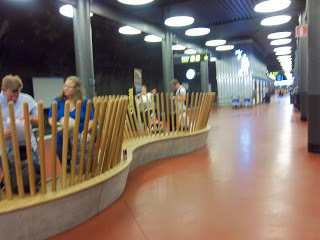 In the high-speed train stationThe HTL Hotel was another example of high tech design. It’s no wonder that IKEA started in Sweden. I was so impressed with the design that I took a picture of our hotel room - something I’ve never done before. The room was small and had no closets or dressers. Two ample draws were built in under the bed. Several hooks were placed on each wall for hanging clothes. Although it looked small, there was enough needed space especially for a few day stay.
In the high-speed train stationThe HTL Hotel was another example of high tech design. It’s no wonder that IKEA started in Sweden. I was so impressed with the design that I took a picture of our hotel room - something I’ve never done before. The room was small and had no closets or dressers. Two ample draws were built in under the bed. Several hooks were placed on each wall for hanging clothes. Although it looked small, there was enough needed space especially for a few day stay.
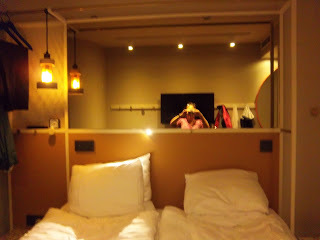 In the HTL HotelOn the Under the Canals boat-tour, we rode past a “passive” apartment building. The narrator explained that it was termed “passive” because its net energy use was zero. Each apartment in the building has a pipe for depositing waste that is funneled into a nearby recycling station that transforms the waste into biofuel. Another pipe into the apartments brings the apartments biofuel that is then used for heat and electricity. In a recent survey, 77% of Swedes said that they’d be willing to pay higher rents to live in a passive apartment.
In the HTL HotelOn the Under the Canals boat-tour, we rode past a “passive” apartment building. The narrator explained that it was termed “passive” because its net energy use was zero. Each apartment in the building has a pipe for depositing waste that is funneled into a nearby recycling station that transforms the waste into biofuel. Another pipe into the apartments brings the apartments biofuel that is then used for heat and electricity. In a recent survey, 77% of Swedes said that they’d be willing to pay higher rents to live in a passive apartment.
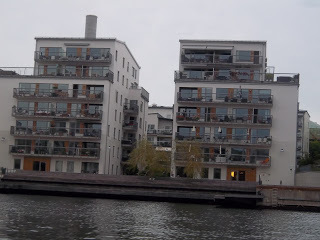 A "Passive" Apartment BuildingThroughout Scandinavia we saw buses running on solar energy and other renewable fuels.
A "Passive" Apartment BuildingThroughout Scandinavia we saw buses running on solar energy and other renewable fuels.
Especially in Copenhagen – but throughout Scandinavia – we were amazed by the amount of people riding bikes instead of cars. In Copenhagen, bicyclists definitely have the right of way and wide, safe bike lanes. Without a doubt bicyclists have the critical mass and have changed the way in which people move from place to place. Instead of huge parking lots for cars, one sees huge bicycle parking lots. For those who don’t bike, of course, they had plenty of public transportation. As a result, there are many fewer cars on the road than one would see in an American city.
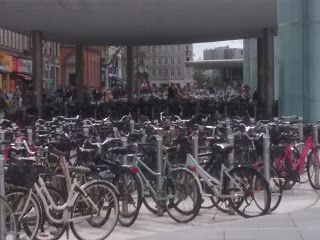 Copenhagen Parking LotThe Scandinavians are definitely leading the way in terms of ecology. Hopefully, the rest of the world will follow them in this regard. On a positive note, enough countries have signed the Paris Accord on global warming to make it a binding treaty by the end of 2016. People in all countries will have to look for ways to save energy. They can look to the Scandinavians for some innovative ways to do it.
Copenhagen Parking LotThe Scandinavians are definitely leading the way in terms of ecology. Hopefully, the rest of the world will follow them in this regard. On a positive note, enough countries have signed the Paris Accord on global warming to make it a binding treaty by the end of 2016. People in all countries will have to look for ways to save energy. They can look to the Scandinavians for some innovative ways to do it.
At the Stockholm airport, we took an elevator one floor down to get on a high-speed train that took us into downtown at 135 miles per hour. The thirty-mile ride took nineteen minutes and brought us to the Central Train Station a ten -minute walk from our hotel.
 In the high-speed train stationThe HTL Hotel was another example of high tech design. It’s no wonder that IKEA started in Sweden. I was so impressed with the design that I took a picture of our hotel room - something I’ve never done before. The room was small and had no closets or dressers. Two ample draws were built in under the bed. Several hooks were placed on each wall for hanging clothes. Although it looked small, there was enough needed space especially for a few day stay.
In the high-speed train stationThe HTL Hotel was another example of high tech design. It’s no wonder that IKEA started in Sweden. I was so impressed with the design that I took a picture of our hotel room - something I’ve never done before. The room was small and had no closets or dressers. Two ample draws were built in under the bed. Several hooks were placed on each wall for hanging clothes. Although it looked small, there was enough needed space especially for a few day stay. In the HTL HotelOn the Under the Canals boat-tour, we rode past a “passive” apartment building. The narrator explained that it was termed “passive” because its net energy use was zero. Each apartment in the building has a pipe for depositing waste that is funneled into a nearby recycling station that transforms the waste into biofuel. Another pipe into the apartments brings the apartments biofuel that is then used for heat and electricity. In a recent survey, 77% of Swedes said that they’d be willing to pay higher rents to live in a passive apartment.
In the HTL HotelOn the Under the Canals boat-tour, we rode past a “passive” apartment building. The narrator explained that it was termed “passive” because its net energy use was zero. Each apartment in the building has a pipe for depositing waste that is funneled into a nearby recycling station that transforms the waste into biofuel. Another pipe into the apartments brings the apartments biofuel that is then used for heat and electricity. In a recent survey, 77% of Swedes said that they’d be willing to pay higher rents to live in a passive apartment. A "Passive" Apartment BuildingThroughout Scandinavia we saw buses running on solar energy and other renewable fuels.
A "Passive" Apartment BuildingThroughout Scandinavia we saw buses running on solar energy and other renewable fuels.Especially in Copenhagen – but throughout Scandinavia – we were amazed by the amount of people riding bikes instead of cars. In Copenhagen, bicyclists definitely have the right of way and wide, safe bike lanes. Without a doubt bicyclists have the critical mass and have changed the way in which people move from place to place. Instead of huge parking lots for cars, one sees huge bicycle parking lots. For those who don’t bike, of course, they had plenty of public transportation. As a result, there are many fewer cars on the road than one would see in an American city.
 Copenhagen Parking LotThe Scandinavians are definitely leading the way in terms of ecology. Hopefully, the rest of the world will follow them in this regard. On a positive note, enough countries have signed the Paris Accord on global warming to make it a binding treaty by the end of 2016. People in all countries will have to look for ways to save energy. They can look to the Scandinavians for some innovative ways to do it.
Copenhagen Parking LotThe Scandinavians are definitely leading the way in terms of ecology. Hopefully, the rest of the world will follow them in this regard. On a positive note, enough countries have signed the Paris Accord on global warming to make it a binding treaty by the end of 2016. People in all countries will have to look for ways to save energy. They can look to the Scandinavians for some innovative ways to do it.
Published on September 22, 2016 06:00
September 15, 2016
What Are Those Norwegians So Happy About?
Before traveling to Scandinavia, I wondered how the Danes and Norwegians always appeared in worldwide polls as the happiest people with the greatest overall sense of well -being. They live in a place with long, cold, dark winters even worse than Chicago’s. On our trip, I found out.
Yes, they have beautiful places where they can enjoy the outdoors. The fiords and mountains were spectacular to see. We heard from our guide that most Norwegians live for their opportunities to be outdoors skiing and otherwise enjoying their beautiful mountains.

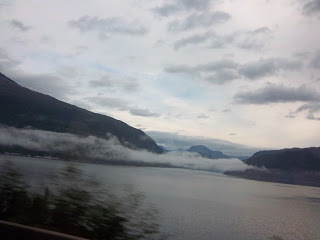


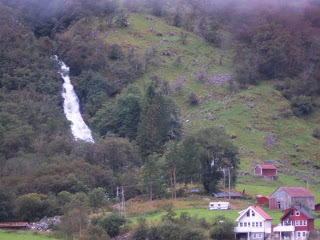
There has to be more to their secret of national happiness than the beautiful scenery and there is. Norway has an extremely admirable social safety network. National healthcare is virtually free to all Norwegians. The government pays for daycare and most Norwegian women work outside the home. They get a 47- week paid parental leave. What can you say to that besides “Wow!”?
All laws are gender-neutral and in many families, the father is the one to stay home. After the leave, the parent has the option of working part-time. Those women who don’t work are looked down upon by most of Norwegian society. The unions set the wage scales and the least anyone makes is $20 per hour. Of course, school through University is free.
Any Norwegian who has worked 40 years gets a pension worth about two thirds of his (her) salary starting at age 62. Anyone who has worked less than that can work until age 67 and get part of that amount. If someone needs to go to assisted living when they are elderly, he (she) pays 80% of his (her) pension check and their government pays the rest.
Norwegians are taxed heavily to pay for this generous social safety net. As a result, no one there is extremely wealthy. People there pride themselves on having a more equal society. If you want to become uber-rich, don’t go there. In Oslo, I was impressed when we were told to visit their most prominent, wealthy hotel. It was very nice, but I was impressed by how unimpressive it was. The Palmer House in Chicago is much ritzier. If you want to live in a society where everyone has at least the basics and nobody is homeless, Norway is the place to go. Most Norwegians will accept you as long as you work, learn to speak Norwegian, and try to fit into the norms of their society.
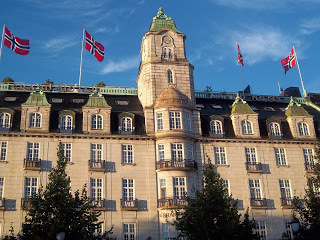
Of course, a social safety doesn’t prevent all problems. People can still become physically or mentally ill or develop addictions. They can still have family problems, disabilities, or other emotional difficulties. Nevertheless, I think how much easier it would have been for my former clients’ issues to be resolved had their lives been stabilized be such a safety net. We can certainly learn from the Scandinavians in this respect. In a way, it’s what my book Breaking the Fall is all about.

Yes, they have beautiful places where they can enjoy the outdoors. The fiords and mountains were spectacular to see. We heard from our guide that most Norwegians live for their opportunities to be outdoors skiing and otherwise enjoying their beautiful mountains.





There has to be more to their secret of national happiness than the beautiful scenery and there is. Norway has an extremely admirable social safety network. National healthcare is virtually free to all Norwegians. The government pays for daycare and most Norwegian women work outside the home. They get a 47- week paid parental leave. What can you say to that besides “Wow!”?
All laws are gender-neutral and in many families, the father is the one to stay home. After the leave, the parent has the option of working part-time. Those women who don’t work are looked down upon by most of Norwegian society. The unions set the wage scales and the least anyone makes is $20 per hour. Of course, school through University is free.
Any Norwegian who has worked 40 years gets a pension worth about two thirds of his (her) salary starting at age 62. Anyone who has worked less than that can work until age 67 and get part of that amount. If someone needs to go to assisted living when they are elderly, he (she) pays 80% of his (her) pension check and their government pays the rest.
Norwegians are taxed heavily to pay for this generous social safety net. As a result, no one there is extremely wealthy. People there pride themselves on having a more equal society. If you want to become uber-rich, don’t go there. In Oslo, I was impressed when we were told to visit their most prominent, wealthy hotel. It was very nice, but I was impressed by how unimpressive it was. The Palmer House in Chicago is much ritzier. If you want to live in a society where everyone has at least the basics and nobody is homeless, Norway is the place to go. Most Norwegians will accept you as long as you work, learn to speak Norwegian, and try to fit into the norms of their society.

Of course, a social safety doesn’t prevent all problems. People can still become physically or mentally ill or develop addictions. They can still have family problems, disabilities, or other emotional difficulties. Nevertheless, I think how much easier it would have been for my former clients’ issues to be resolved had their lives been stabilized be such a safety net. We can certainly learn from the Scandinavians in this respect. In a way, it’s what my book Breaking the Fall is all about.

Published on September 15, 2016 06:00



